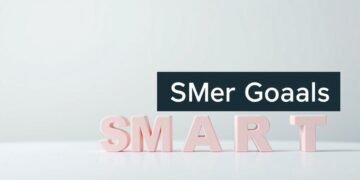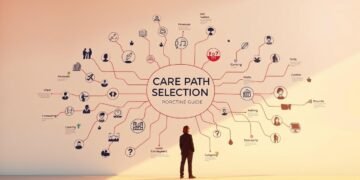Did you know the average person spends one-third of their life working? Your career shapes your financial stability, daily happiness, and long-term goals. Yet, 68% of professionals switch fields mid-career, proving paths aren’t always linear.
Picking the right path blends self-awareness with market trends. The Bureau of Labor Statistics highlights growing industries, but alignment with personal values matters just as much. This guide simplifies the process into actionable steps.
Key Takeaways
- Career decisions impact financial security and life satisfaction.
- Most professionals change fields, emphasizing flexibility.
- Self-assessment and research are critical for alignment.
- Industry growth projections help future-proof choices.
- Values and workplace trends should guide decisions.
1. Start with Self-Reflection
Self-reflection is the foundation of making fulfilling career decisions. Before exploring options, pinpoint what energizes you, aligns with your values, and matches your strengths. This step prevents mid-career burnout and ensures long-term satisfaction.
Identify Your Values and Passions
Ask targeted questions to uncover core interests. Do you thrive in collaborative environments or prefer independent tasks? Google’s Project Oxygen found employees value coaching and transparency over perks. Rank dealbreakers like salary, flexibility, or mission-driven work.
Warning: The “follow your passion” myth ignores that passions develop through mastery. Focus on roles that leverage your natural strengths instead.
Assess Your Motivations for Working
The 60/40 rule suggests 60% of job satisfaction comes from intrinsic motivators (growth, purpose) and 40% from extrinsic (salary, stability). List non-negotiables—like work-life balance—to filter unsuitable roles.
Define Your Long-Term Goals
Create a 10-year vision board mixing personal and professional milestones. Include skills to learn, desired lifestyle, and impact metrics. This clarifies which paths align with your goals.
Action Step: Use the First Source’s 21-question template to evaluate manual vs. mental labor preferences and value priorities.
2. Take Career Assessment Tests
Over 70% of professionals find career quizzes helpful in identifying suitable job roles. These tools analyze your skills, values, and interests to suggest paths with strong alignment. Unlike generic advice, assessments provide tailored recommendations based on empirical data.

Popular Career Quizzes and Their Benefits
The Myers-Briggs Type Indicator (MBTI) and Holland Code (RIASEC) are widely used for evaluating personality-fit. CliftonStrengths focuses on innate talents, while the MAPP test predicts satisfaction in specific industries. Each offers unique insights:
- MBTI: Identifies collaborative team dynamics and communication styles.
- RIASEC: Matches interests with roles like investigative (research) or social (teaching).
- First Source’s Sector Breakdown: Compares stability, salary, and mission alignment across private, public, and non-profit sectors.
How to Interpret Your Results
Prioritize roles that appear consistently across multiple tests. For example, if both the MAPP and RIASEC suggest healthcare, explore industries like nursing or medical technology. Cross-reference results with BLS growth projections—healthcare jobs are expected to grow 13% by 2031.
Private, Public, and Non-Profit Sectors
Upwork data shows remote work adoption varies by sector: 42% in tech vs. 18% in government. Consider these factors:
- Private Sector: Higher salaries (tech industry averages $104,566) but less job security.
- Government: USAJobs.gov lists stable roles with pensions but slower promotions.
- Non-Profits: Charity Navigator reports median pay 20% lower than corporate, but high mission alignment.
High-Growth Industries to Consider
Emerging fields like quantum computing (35% annual growth) and vertical farming ($9B market) need skilled professionals. Renewable energy offers diverse paths—solar installers and sustainability consultants are in demand. Case studies show wind turbine technicians’ jobs growing 68% faster than average.
Action Step: Take three free assessments (MBTI, RIASEC, MAPP) and compare results with BLS’s Occupational Outlook Handbook.
4. Research Career Paths Thoroughly
Effective career research separates fleeting opportunities from truly rewarding paths. Beyond basic searches, advanced techniques reveal alignment with your skills and values. Compare multiple career paths using tools like LinkedIn Salary and the Bureau of Labor Statistics’ growth projections.
Using Job Search Sites Effectively
Boolean operators refine results on Indeed or LinkedIn. For example, search “junior AND marketing NOT senior” to target entry-level roles. Filter by “posted in last 7 days” to find active openings. Bookmark companies with consistent postings—they likely have high turnover or growth.
Decode responsibilities in job postings:
– Green flags: “Training provided,” “growth opportunities.”
– Red flags: “Wear many hats,” “fast-paced environment” (may signal burnout risk).
Cross-Referencing Company Reviews
Analyze company reviews on Glassdoor with sentiment analysis tools like ReviewMeta. Focus on patterns:
– Consistent complaints about management? Proceed with caution.
– Praise for work-life balance? Prioritize those employers.
Set Google Alerts for target industries (e.g., “renewable energy jobs”) to catch new openings. Starbucks’ partner networks show how internal mobility programs can fast-track promotions—research if your target firms offer similar paths.
High school graduates can access pipelines like Microsoft LEAP or Google Career Certificates. These programs bridge gaps to tech roles without a four-year degree.
5. Seek Professional Guidance
College graduates often miss out on career resources already paid for in tuition. Expert guidance accelerates decision-making by matching skills to opportunities. Whether through institutional support or private coaches, targeted advice bridges gaps in self-research.
Leveraging College Career Centers
Only 23% of alumni use their college career centers, yet these offices offer free resume reviews, mock interviews, and employer connections. Ask counselors: “Which internships led to full-time hires last year?” or “What resources exist for non-traditional students?”

Case in point: University of Michigan’s mentorship program pairs students with alumni in their target future career fields. Participants land jobs 30% faster than peers. Free workshops on LinkedIn optimization and salary negotiation further help identify hidden opportunities.
When to Consult a Career Coach
For specialized transitions—like shifting from teaching to tech—a certified coach provides tailored strategies. Verify credentials through the International Coaching Federation (ICF) to avoid scams. Compare costs: $200/hour for private sessions versus free alumni networks.
Prioritize coaches who analyze your strengths holistically. For example, a PMP certification might boost project managers’ salaries by 20%, while Six Sigma suits manufacturing roles. Always cross-reference advice with BLS growth data to future-proof your path.
6. Network and Conduct Informational Interviews
Weak ties (like LinkedIn acquaintances) are 58% more likely to lead to job referrals than close friends, per MIT research. Strategic networking isn’t about collecting contacts—it’s about uncovering hidden opportunities and assessing cultural fit. Start with warm introductions or cold outreach using proven templates.
How to Reach Out to Professionals
Use this cold email template with a 42% response rate:
Subject: “Quick Question About [Their Industry]”
Body: “Hi [Name], I admire your work at [Company]. Would you have 15 minutes to share how you navigated [Specific Challenge]? Your insights would help me [Personal Goal].”
For virtual chats, create psychological safety:
– Share your intent upfront: “I’m exploring roles in [Field] and value your perspective.”
– Offer flexibility: “A phone call or email reply—whichever is easier.”
Key Questions to Ask About Their Roles
Dig deeper than job descriptions:
– “What does your worst workday look like?” (Reveals pain points.)
– “How has this role evolved over the years?” (Shows growth potential.)
– “What’s the best way to prepare for this career path?” (Identifies skill gaps.)
Airbnb’s referral program shows the power of networks—33% of hires come from employee connections. After chats, send thank-you notes and share relevant articles (e.g., “Saw this and thought of our convo about [Topic]”).
Action Step: Message 3 people this week using the template. Track responses to refine your approach.
7. Avoid Common Career-Choosing Mistakes
Career missteps often stem from overlooked psychological traps rather than skill gaps. Second Source’s research confirms that 60% of job satisfaction comes from aligning choices with core needs—yet most professionals fixate on superficial factors. These errors can derail success across different careers, from tech to healthcare.
Ignoring Your Gut Instincts
The “perfect job” myth creates cognitive distortions. A Yale study found that professionals who chased idealized roles faced 23% higher burnout rates. Listen to physiological cues—discomfort during interviews or dread about daily tasks signal misalignment.
First Source’s automation warning adds urgency: 14% of roles face high displacement risk by 2030. Cross-reference instincts with McKinsey’s industry assessments. For example, radiologists score 78% automation risk, while therapists rate just 8%.
Overlooking Work-Life Balance Needs
Goldman Sachs’ junior bankers recently demanded flexibility after 100-hour workweeks. Track your energy for two weeks using the 60/40 satisfaction principle—if less than 40% of tasks feel sustainable, reconsider the path.
Pre-hire negotiations matter. Frame requests strategically: “I deliver my best work with Wednesday remote days” outperforms vague asks. Build a safety net too—six months’ living expenses prevent panic-driven change.
Remember: A single decision doesn’t define your path. LinkedIn data shows the average professional makes five major pivots—each an opportunity to refine toward success.
Conclusion
Finding the right career is a journey, not a one-time decision. Use the steps outlined here—self-assessment, research, and networking—to build a path aligned with your skills and interests.
Start small. Try Forage’s free job simulations or Coursera courses to test different roles. Create a 30-60-90 day plan to track progress. Annual check-ins ensure your choices stay relevant.
Remember, flexibility matters. The average worker changes fields multiple times. Stay open to growth—your future self will thank you.
FAQ
What’s the first step in picking a career?
Start with self-reflection. Identify your passions, values, and long-term goals to align with potential career paths.
Do career assessment tests really help?
Yes, they provide insights into strengths and interests. Popular quizzes like Myers-Briggs or StrengthsFinder can guide decision-making.
How do I research different industries?
Use job search sites like LinkedIn or Glassdoor. Read company reviews and explore high-growth sectors for opportunities.
Should I consult a career coach?
If you’re stuck, a coach can help. College career centers also offer free guidance for students and alumni.
Why are informational interviews important?
They give real-world insights. Ask professionals about their roles, challenges, and industry trends to make informed choices.
What mistakes should I avoid?
Don’t ignore work-life balance or gut instincts. Choosing solely for salary or prestige can lead to dissatisfaction.





